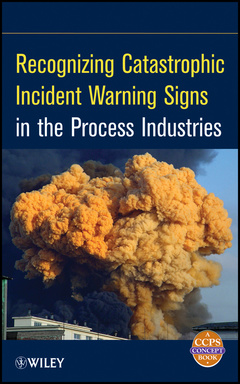Description
Recognizing Catastrophic Incident Warning Signs in the Process Industries
Author: CCPS (Center for Chemical Process Safety)
Language: English
Subject for Recognizing Catastrophic Incident Warning Signs in the...:
Approximative price 140.84 €
In Print (Delivery period: 14 days).
Add to cart272 p. · 16.1x24.3 cm · Hardback
Description
/li>Contents
/li>Biography
/li>
List of Figures xxi
Files on the Web Accompanying This Book xxii
Acknowledgements xxv
Foreword xxvii
Preface xxix
1. Introduction 1
1.1 Process safety management 3
1.2 Normalization of deviance 4
1.3 A strategy for response 5
1.4 Maintaining organizational memory and a healthy sense of vulnerability 7
1.5 Risk based process safety 8
1.6 Our target audience 11
1.7 How to use this book 12
1.8 Case study – Toxic gas release in India 13
2. Incident Mechanics 17
2.1 Incidents do not just happen 17
2.2 Incident models 17
2.3 Case study – Benzene plant explosion in China 27
3. Leadership and Culture 29
3.1 How does leadership affect culture? 29
3.2 The leadership and culture related warning signs 32
3.3 Case study – Challenger space shuttle explosion in the US 46
4. Training and Competency 49
4.1 What is effective training and how is competency measured? 49
4.2 The training and competency related warning signs 51
4.3 Case study – Gas plant vapor cloud explosion in Australia 62
5. Process Safety information 65
5.1 Critical information to identify hazards and manage risk 65
5.2 The process safety information related warning signs 66
5.3 Case study – Batch still fire and explosion in the UK
6. Procedures 79
6.1 Safe and consistent operation 79
6.2 The procedure related warning signs 81
6.3 Case study – Nuclear plant meltdown and explosion in the Ukraine 95
7. Asset Integrity 97
7.1 Systematic implementation 97
7.2 The asset integrity related warning signs 99
7.3 Case study – Refinery naphtha fire in the US 114
8. Analyzing Risk and Managing Change 177
8.1 Risk management 117
8.2 The risk analysis and management of change related warning signs 121
8.3 Case study – Cyclohexane explosion in the UK
9. Audits 139
9.1 Audits support operational excellence 139
9.2 The audit related warning signs 141
9.3 Case study – Chemical warehouse fire in the UK
10. Learning From Experience 149
10.1 Methods for continuous improvement 149
10.2 The learning from experience warning signs 151
10.3 Case study – Space shuttle Columbia incident in the US 159
11. Physical Warning Signs 163
11.1 The everyday things matter 163
11.2 The physical warning signs 164
11.3 Case study – Resin plant dust explosion in the US 172
12. A Call to Action 175
12.1 Actions you can take now for each warning sign 176
12.2 A simple plan to consider for rigorous implementation and follow-up 177
12.3 Actions to consider 180
12.4 Summary 183
Appendix A. Incident Warning Sign Self Assessment Tool 187
Appendix B. Composite List of Catastrophic Incident Warning Signs 199
References & Selected Regulations 205
Acronyms and Abbreviations 213
Glossary 215
Index 221
Since 1985, the Center for Chemical Process Safety (CCPS) has been the world leader in developing and disseminating information on process safety management and technology. CCPS, an industry technology alliance of the American Institute of Chemical Engineers (AIChE), has published over eighty books in its process safety guidelines and process safety concepts series, and over a hundred training modules through its Safety in Chemical Engineering Education (SACHE) series.




